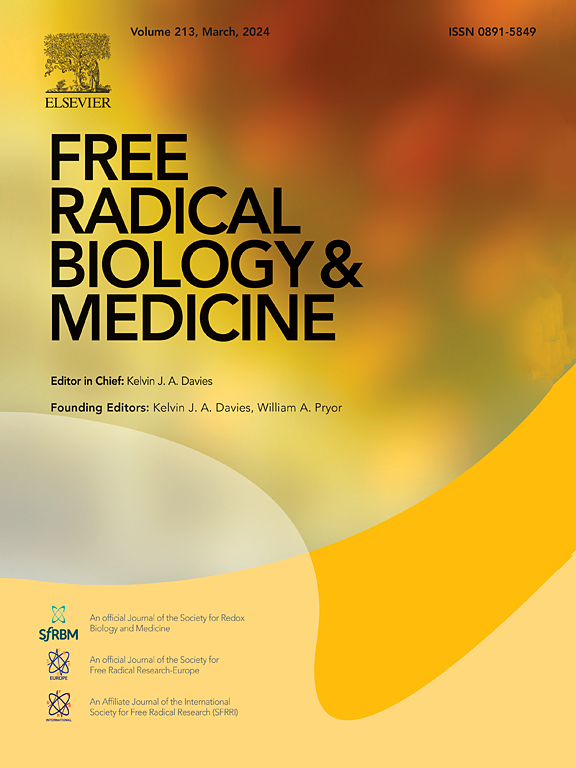Reductive stress and mitochondrial dysfunction: The hidden link in chronic disease
IF 7.1
2区 生物学
Q1 BIOCHEMISTRY & MOLECULAR BIOLOGY
引用次数: 0
Abstract
Conventional theories of oxidative stress have long focused on the deleterious consequences of excessive reactive oxygen species (ROS) formation. However, growing evidence reveals that an overload of reducing equivalents—termed reductive stress—may be equally pivotal in driving mitochondrial dysfunction and chronic disease. In this paradigm, abnormally high concentrations of NADH and NADPH create an electron “traffic jam” in the mitochondrial electron transport chain (ETC), leading to partial inhibition or reverse electron flow at upstream complexes. Paradoxically, this hyper-reduced environment promotes ROS generation by increasing electron leakage to molecular oxygen, thereby intensifying oxidative damage to lipids, proteins, and mitochondrial DNA.
This review explores the intertwined nature of reductive and oxidative stress, showing how a surplus of reducing equivalents can potentiate metabolic derangements in conditions such as type 2 diabetes, nonalcoholic fatty liver disease, and neurodegenerative disorders. The review discusses common drivers of reductive overload, including chronic hyperglycemia, high-fat diets, and specific dietary patterns—particularly those enriched in polyunsaturated omega-6 fatty acids—that inundate mitochondria with electron donors. The review also highlights emerging evidence that targeted assessment of redox biomarkers (e.g., lactate:pyruvate, β-hydroxybutyrate:acetoacetate ratios) can provide clinically relevant indicators of reductive stress.
Finally, the review examines how novel therapeutic strategies can address the underlying reductive imbalance, from rational nutrient modulation to pharmacologic interventions that restore NAD+ levels or optimize ETC flux. Recognizing reductive stress as a critical inflection point in mitochondrial pathophysiology underscores the need for a refined redox framework, one that moves beyond conventional oxidative paradigms to embrace the full spectrum of redox dysregulation in chronic degenerative disease.

还原性应激和线粒体功能障碍:慢性疾病的隐藏联系。
传统的氧化应激理论长期以来一直关注过多活性氧(ROS)形成的有害后果。然而,越来越多的证据表明,过度减少等量物(称为还原性压力)可能在驱动线粒体功能障碍和慢性疾病方面同样关键。在这种情况下,异常高浓度的NADH和NADPH在线粒体电子传递链(ETC)中产生电子“交通堵塞”,导致上游复合物的部分抑制或反向电子流。矛盾的是,这种超还原环境通过增加电子向分子氧的泄漏来促进ROS的产生,从而加剧对脂质、蛋白质和线粒体DNA的氧化损伤。这篇综述探讨了还原性和氧化性应激相互交织的本质,揭示了还原性当量的过剩如何加剧2型糖尿病、非酒精性脂肪肝和神经退行性疾病等疾病的代谢紊乱。我们讨论了还原性超负荷的常见驱动因素,包括慢性高血糖症、高脂肪饮食和特定的饮食模式——特别是那些富含多不饱和ω -6脂肪酸的饮食模式——它们会使线粒体充斥着电子供体。我们还强调了新出现的证据,即有针对性地评估氧化还原生物标志物(例如,乳酸:丙酮酸,β-羟基丁酸:乙酰乙酸比率)可以提供临床相关的还原性应激指标。最后,我们研究了新的治疗策略如何解决潜在的还原性失衡,从合理的营养调节到恢复NAD+水平或优化ETC通量的药物干预。认识到还原性应激是线粒体病理生理学的一个关键拐点,强调需要一个完善的氧化还原框架,一个超越传统氧化范式的框架,以涵盖慢性退行性疾病中氧化还原失调的全谱。
本文章由计算机程序翻译,如有差异,请以英文原文为准。
求助全文
约1分钟内获得全文
求助全文
来源期刊

Free Radical Biology and Medicine
医学-内分泌学与代谢
CiteScore
14.00
自引率
4.10%
发文量
850
审稿时长
22 days
期刊介绍:
Free Radical Biology and Medicine is a leading journal in the field of redox biology, which is the study of the role of reactive oxygen species (ROS) and other oxidizing agents in biological systems. The journal serves as a premier forum for publishing innovative and groundbreaking research that explores the redox biology of health and disease, covering a wide range of topics and disciplines. Free Radical Biology and Medicine also commissions Special Issues that highlight recent advances in both basic and clinical research, with a particular emphasis on the mechanisms underlying altered metabolism and redox signaling. These Special Issues aim to provide a focused platform for the latest research in the field, fostering collaboration and knowledge exchange among researchers and clinicians.
 求助内容:
求助内容: 应助结果提醒方式:
应助结果提醒方式:


